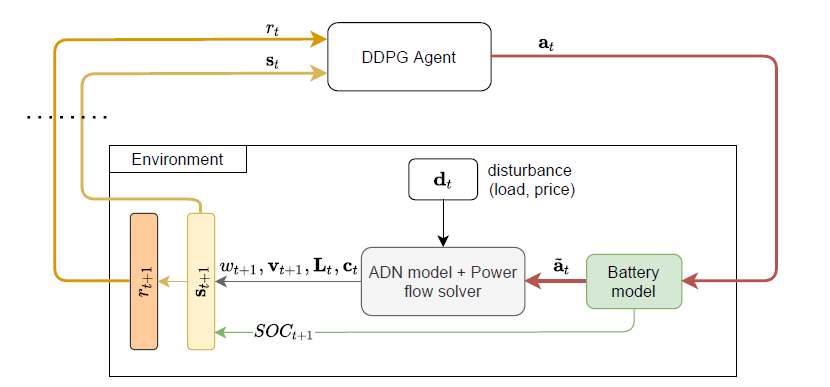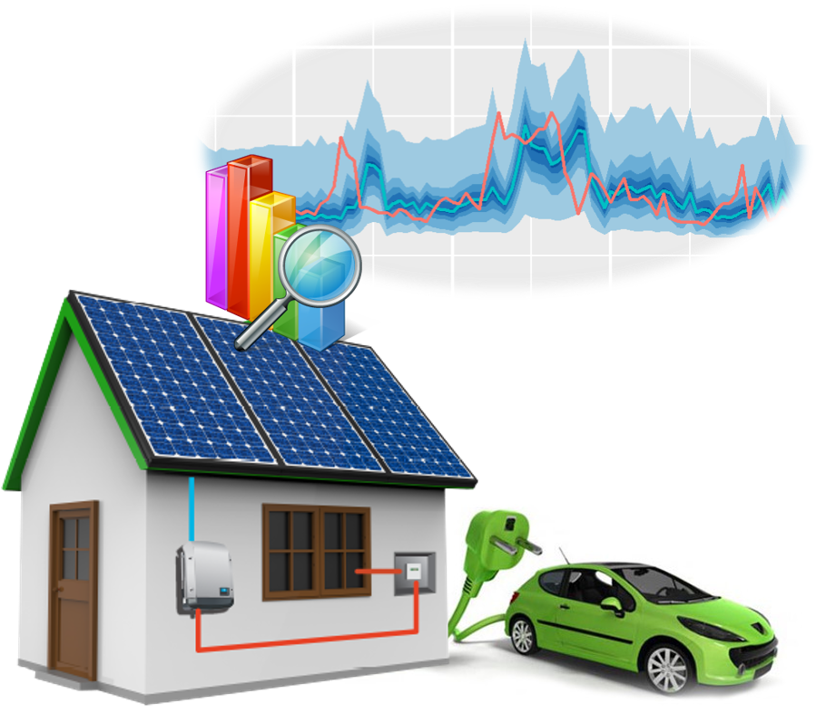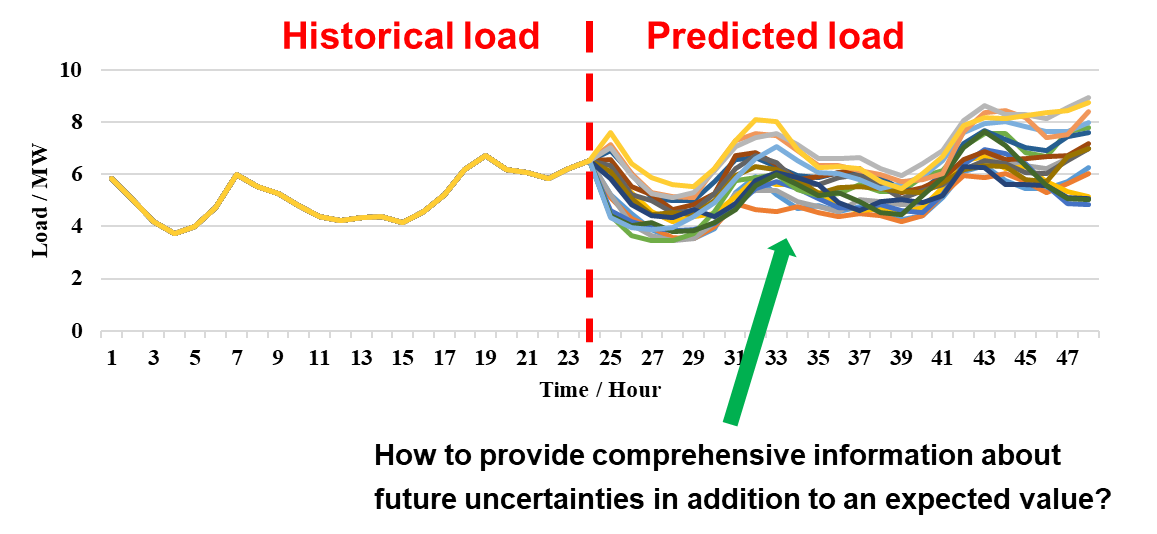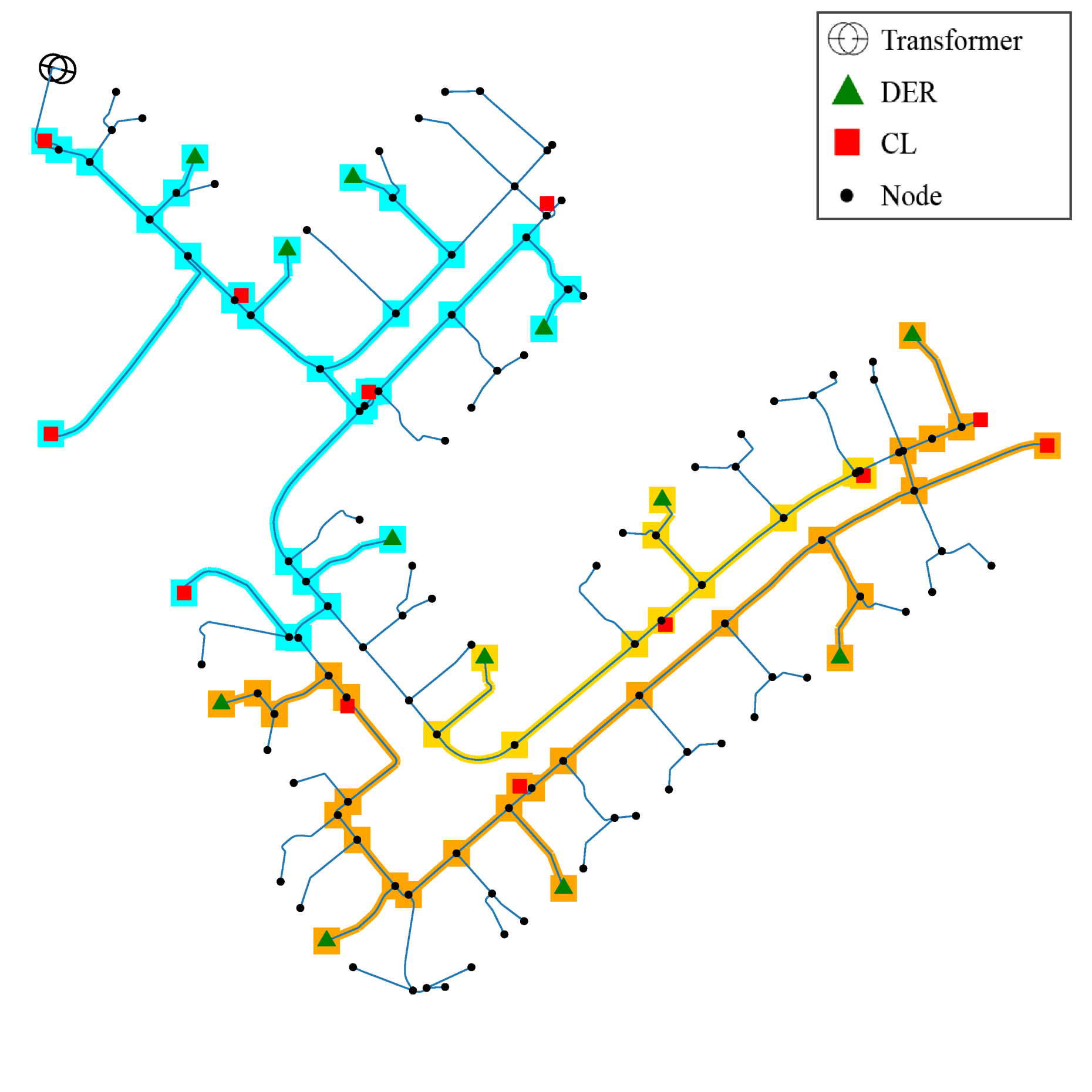Digitalization in Electric Power Systems
The collection and transmission of measurement data to the control center enables system operators to monitor closely the state of the system. The traditional state estimation problem that tries to identify the state of the system from these measurements is non-linear and is usually applied only to the higher voltage levels.
The deployment of phasor measurement units, which provide very accurate measurements of voltage and current phasors, at the transmission level and the rapidly increasing penetration of measurement equipment at the distribution level, e.g. smart meters, have led to a revival of research in state estimation and utilization of data for monitoring and control in general.
At PSL, an efficient linear state estimator for transmission systems was derived which will also serves as the basis for future research studying how to mitigate cybersecurity risks and to enable transparency at the distribution system level. Aside from simply monitoring, the availability of data furthermore allows for the design of localized data-based and distributed decision making approaches as well as for predictions of distributed generation and demand. Hence, PSL has developed elaborate methods using machine learning based approaches for these purposes.
Optimal control of battery enhanced active distribution grids in diverse time scales
We perform optimal control of the operation of battery-enhanced power grids in different time scales (operation-ahead and real-time) and in presence of intermittent renewable energy sources (RESs).
Power grids are characterized by an increasing penetration of uncertain RESs. This uncertainty in combination with the need of balancing demand with supply leads to a continuously growing required amount of reserves. However, traditional reserves (fossil fuel-based) are costly and increase the operational and investment costs for the power grid. On the other side, batteries can absorb the uncertainty of RESs, e.g., charge to consume energy when RESs over-generate and vice versa. In order to exploit the full potential of batteries, we should optimally plan and control their operation taking into account RESs uncertainty.
Operation-ahead Optimization1,2:
We are working on computing, a-priori the operation (e.g., day-ahead), a dispatch plan (i.e., a set of power values over a future time horizon) at a point of the power grid where heterogeneous resources such as batteries, RESs and loads are grouped together. This point is usually the Point of Common Coupling (PCC) of the distribution grid with the main grid. A dispatch plan is applied unchanged during operation with the aim of being followed by a real-time scheme that controls batteries. It can be also updated over an intra-day timescale. Dispatching is crucial for a more predictable and stable operation of the power grid in presence of the uncertainties. To compute efficient dispatch plans for distribution grids, the uncertainty of RESs, the grid and battery losses, as well as the grid and battery constraints should be taken into account. This leads to the need of solving stochastic, non-convex optimization problems. We treat uncertainty using scenario-based optimization that can model generic uncertainty distributions and any existing time correlations. To handle non-convexity, our proposed approach consists in approximating the terms responsible for non-convexity with constants and then iteratively solve the derived convex optimization problem and update the constant values until convergence.
Real-time Control3:
We are working on controlling batteries in a fast time-scale, while the actual prosumption is being revealed. Often, the aim of the real-time control is to track a given dispatch plan at the PCC or to buy and sell energy at the PCC. Forecasting errors are unavoidable and thus, online control schemes are indispensable and should trade-off optimality with computational speed. Model Predictive Control (MPC) is the most commonly used solution practice. Nonetheless, MPC schemes do not scale for real-time applications due to computational limitations, while they also require forecast values. Targeting at alleviating these issues, in our research, we are working on developing reinforcement learning-based schemes using the Deep Deterministic Policy Gradient algorithm that is suitable for continuous state and action spaces.
Contact: Dr. Eleni Stai
1 E. Stai, L. Reyes-Chamorro, F. Sossan, J. Le Boudec and M. Paolone, "Dispatching Stochastic Heterogeneous Resources Accounting for Grid and Battery Losses," in IEEE Transactions on Smart Grid, vol. 9, no. 6, pp. 6522-6539, Nov. 2018.
2 E. Stai, C. Wang and J. -Y. Le Boudec, "On the Solution of the Optimal Power Flow for Three-Phase Radial Distribution Networks With Energy Storage," in IEEE Transactions on Control of Network Systems, vol. 8, no. 1, pp. 187-199, March 2021.
3 E. Stai, C. Wang and J. -Y. Le Boudec, "Online Battery Storage Management via Lyapunov Optimization in Active Distribution Grids," in IEEE Transactions on Control Systems Technology, vol. 29, no. 2, pp. 672-690, March 2021.
In recent years, electric power systems have been experiencing a shift in paradigm from conventional energy sources to renewable energy sources (RES). Additionally, new loads are being introduced, such as electric vehicles, heat pumps, etc. High penetration of renewables, alongside their intermittency, renders power flow patterns less predictable and system dynamics significantly faster. Therefore, the focus of the power system community is moving from static state estimation (SSE) towards dynamic state estimation (DSE).
DSE uses dynamic equations given in a generic way by
x ̇=f(x(t),y(t),u(t)), (1)
0=g(x(t),y(t),u(t)). (2)
Equations (1)–(2) represent a set of nonlinear, differential-algebraic equations that govern the dynamic behavior of the whole system. We are interested in estimating system states, at each time step, in a recursive fashion. Kalman filter and its nonlinear variants are standard tools used in literature to perform this task. In particular, we try to make these estimators robust against topology errors, parameter uncertainty, and cyber-attacks. To achieve this goal, least-absolute value (LAV), H_∞ or distributionally robust estimators can be employed. Besides robustness, other aspects, such as scalability and computational tractability, have to be addressed to enable the application to high-dimensional systems in practice.
Like many other cyber-physical systems, power systems are extremely safety-critical. Therefore, secure operation and intrusion detection are of paramount importance in everyday operation. As part of the NCCR Automation project, we look into enhancing power systems' security by detecting inconsistent patterns in the measurements collected over time. One way to achieve this goal relies on exploiting the information from previous time steps propagated through the system dynamics. Another way could be using model-free, data-driven methods.
Contact: Milos Katanic
Traditionally considered as a passive black-box component of power systems, the distribution grid currently undergoes a rapid transformation. Especially, it sees the emergence of new types of loads (e.g., electric vehicles, electric heating systems, electric water heaters) as well as distributed energy resources (e.g., small wind turbines, solar photovoltaic systems, battery energy storage systems). Their integration requires increased reliability, efficiency, and adaptability of distribution systems, which inevitably relies on more visibility. Consequently, advanced electricity sensor elements are massively rolled out in distribution grids down to the end-users. The gains in transparency and controllability offered by the advanced metering infrastructure open up an extensive range of new opportunities.
In this context, our work consists of leveraging the large diversity of measurement data generated by the advanced electricity sensors, notably smart meters, for better operation and planning of distribution grids down to the low-voltage level. Data preparation, big data visualization, pseudo-measurement synthesis, state estimation, load disaggregation, and short-term forecasting are among the investigated topics. Based on real-world data, we intend to bridge some of the gaps that currently prevent power utilities and their customers from using the full potential of actual measurement data in distribution grids.
Among others, part of our research is linked to the external pageReMaPcall_made project (i.e., Renewable Management and Real-Time Control Platform). This platform allows to develop and validate new control concepts and components in a seamless process from a pure software environment to a hardware environment. In this framework, advanced algorithms for probabilistic load forecasting have first been designed and tested at the level of a building and of specific flexible domestic devices (e.g., heat pump, domestic hot water, refrigerators). Future steps will focus on the integration of those probabilistic load forecasts into predictive control schemes. Concretely, the control schemes aim to leverage the flexibility of domestic devices for demand response purposes without considerably affecting the users' comfort. Finally, the project will study how the implementation of prediction and data-based control algorithms can co-exist with ensuring sufficient privacy of the consumer.
Contact: Dr. Thierry Zufferey
With the increasing integration of renewable energy, power systems operate in an environment with large uncertainties. Energy forecasting is the basis for power system operation. Thus, there is an increasing need for probabilistic approaches for capturing such uncertainties so that power systems can operate in a more reliable and efficient way. Traditional deterministic forecasting algorithms can only provide expected values of future energy. Probabilistic energy forecasting is an effective approach to model the uncertainty of future energy, which has been widely studied in recent years.
Researchers at PSL are investigating methods and algorithms for probabilistic renewable energy, loads, and price forecasting and focusing on the following important issues in the area of probabilistic energy forecasting:
1) How to take advantage of fine-grained data to enhance the forecasting performance?
2) How to combine multiple forecasting models to further improve the forecasting performance?
3) How to update the model in real-time for efficient adaptation of newly incoming information?
4) How to protect the privacy of distributed datasets when training probabilistic forecasting algorithms?
Contact: Dr. Yi Wang
For the “Control, Detection, and Recovery of Resilient Cyber-Physical Systems” project under the Future Resilient Systems programme at the Singapore-ETH Centre, we work on developing tools and control schemes to enhance the resilience of power grids with high penetration of distributed energy resources.
Some of our recent work has focused on expedited recovery of critical loads in the distribution grid after a large-scale blackout event through the formation of ad hoc microgrids leveraging stochastic energy sources. Taking into account the intermittent characteristics of the generators reduces the instances of restored load shed, where the restored critical load has to be temporarily shed due to insufficient energy production.
On the other hand, due to the large number of stochastic distributed energy resources in the grid, we are also looking into ways of aggregating these resources for more efficient control and management. The metrics and characteristics used for their aggregation are chosen to achieve specific design targets, e.g., reducing variability, or increasing homogeneity. The goal here is to develop an efficient algorithm that is able to aggregate a large number of distributed resources on a regular basis.
Control, Detection and Recovery of Resilient Cyber-Physical Systems
Contact: Dr. Jun Xing Chin




